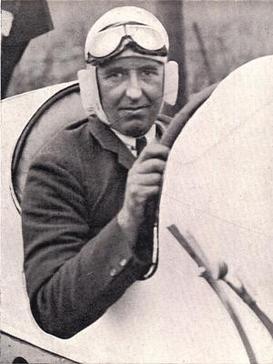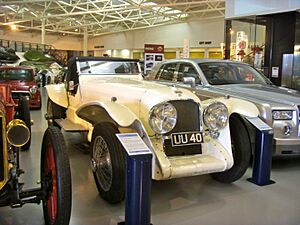J. G. Parry-Thomas facts for kids
Quick facts for kids
John Godfrey Parry-Thomas
|
|
|---|---|
 |
|
| Born | 6 April 1884 Wrexham, Wales
|
| Died | 3 March 1927 (aged 42) Pendine Sands
|
| Cause of death | Serious head injury in motor accident during land speed record attempt |
| Resting place | Byfleet, Surrey |
| Nationality | Welsh |
| Education | Oswestry School, The City and Guilds College London |
| Occupation | Engineer & motor-racing driver |
| Employer | Leyland Motors |
John Godfrey Parry-Thomas (born April 6, 1884 – died March 3, 1927) was a super-fast motor-racing driver and clever engineer from Wales. He once held the amazing land speed record! Sadly, he was the first person to die while trying to break that record.
Contents
Early Life and Learning
John Parry-Thomas was born in Wrexham, Wales. His dad was a church leader. When John was five, his family moved to Oswestry. He went to Oswestry School there. Later, he studied engineering at The City and Guilds College in London.
Working at Leyland Motors
John Parry-Thomas became the main engineer at Leyland Motors. This company mostly made big trucks and buses. John was very inventive. He created many new ideas for electrical and car parts. He even got patents for his inventions.
After World War I, John and his helper, Reid Railton, designed a fancy car. It was called the Leyland Eight. They hoped it would be as good as cars from Rolls-Royce. John drove this car at a famous race track called Brooklands in 1920. This experience made him want to be a full-time racing driver and engineer. So, he left Leyland Motors.
Racing at Brooklands
John teamed up with another engineer, Major Ken Thomson. They started their own company, Thomas Inventions Development Co. Their office was right inside the Brooklands race track! After John passed away, this company became Thomson & Taylor. They went on to build famous cars, like Malcolm Campbell's Blue Bird.
From 1923, John lived in a small house at Brooklands. It was a simple life. He lived only with his two dogs and his racing cars. He was very focused on his work. John did very well at Brooklands. He won 38 races in five seasons. He also set many new speed records there.
Chasing the Land Speed Record
By 1925, John realized he needed more fame to succeed. He decided to try for the land speed record. This record is for the fastest car on land. He bought a special car called the Higham Special. It used to belong to Louis Zborowski, who had passed away.
John rebuilt the car. He gave it a new shape to make it go faster through the air. The car had a huge 27-liter Liberty V-12 airplane engine! John didn't have as much money as other racers like Malcolm Campbell. He also didn't have big factory help like Henry Segrave. So, he couldn't get the newest engines. The car was ready in 1925, but it didn't go as fast as he hoped.
In April 1926, the car got another new body. John named it Babs. He was so excited that he drove it on the roads around Brooklands that night! Even without headlights!
A few days later, John went to Pendine Sands in Wales. This is a long, flat beach where other racers had set records. The sand was soft and wet, but John still managed to break the record! The next day, April 28, 1926, he drove Babs even faster. He reached over 170 miles per hour! This was a world record that lasted for almost a year.
The Final Race
During the winter of 1926 and 1927, Babs got yet another new body. Parts of the car's drive and back wheels were covered. John Parry-Thomas was killed at Pendine Sands on March 3, 1927. He was trying to get his world land speed record back. Malcolm Campbell had just broken it a few weeks before.
At first, people thought a chain on the car broke and hit John. They thought this caused a fatal head injury as the car rolled. But later, when Babs was fixed, experts found this was probably not true. It was more likely that John was hurt when the car rolled and slid on the beach at over 100 miles per hour.
John Parry-Thomas was buried in a churchyard in Byfleet, Surrey. This is close to the Brooklands Circuit. After the accident, Babs was buried in the sand dunes at Pendine Sands. Many years later, in 1969, the car was dug up. Over the next 15 years, a man named Owen Wyn Owen carefully restored it. For part of every summer, Babs was shown at the Pendine Museum of Speed. A new museum building opened in 2023.



